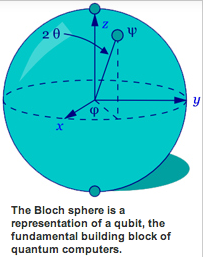What Is Quantum Computing ?
- Quantum Computing was proposed in the 1970s, quantum computing relies on quantum physics by taking advantage of certain quantum physics properties of atoms or nuclei that allow them to work together as quantum bits, or qubits, to be the computer's processor and memory
- They interact with each other while being isolated from the external environment, qubits can perform certain calculations exponentially faster than conventional computers
What Is A Qubit ?
- A qubit is a quantum bit, the counterpart in quantum computing to the binary digit or of classical computing. Just as a bit is the basic unit of information in a classical computer, a qubit is the basic of information in a quantum computer.
- In a quantum comuter, a number of elemental particles such as electrons or photons can be used, with either their change or polarization acting as a representation of 0 and/or 1. Each of these particles is known as qubit; the nature and behavior of these particles form the basis of quantum computing
The Qubit:

Picture Source
Qubit Control:

The next paradigm ?
- The next logical step will eventually be to create quantum computers, which will harness the power of atoms and molecules to perform memory and processing tasks.
- Quantum computers have the potential to perform certain calculations significantly faster than any silicon-based computer
- Scientist have already built basic quantum computers that can perform certain calculations, but a practical quantum computer is still years away
Key Advancements Made:
1998:
- Los Alamos and MIT researchers managed to spread a single qubit across three nuclear spins in each molecule of a liquid solution of alanine (an amino acid used to analyze quantum state decay) or trichloroethylene (a chlorinated hydrocarbon used for quantum error correction) molecules. Spreading out the qubit made it harder to corrupt, allowing researchers to use entanglement to study interactions between states as an indirect method for analyzing the quantum information
2000:
- In March, scientists at Los Alamos National Laboratory announced the development of a 7-qubit quantum computer within a single drop of liquid. The quantum computer uses nuclear magnetic resonance (NMR) to manipulate particles in the atomic nuclei of molecules of trans-crotonic acid, a simple fluid consisting of molecules made up of six hydrogen and four carbon atoms
- Researchers at IBM-Almaden Research Center developed what they claimed was the most advanced quantum computer to date in August. The 5-qubit quantum computer was designed to allow the nuclei of five fluorine atoms to interact with each other as qubits, be programmed by radio frequency pulses and be detected by NMR instruments similar to those used in hospitals
2001:
- Scientists from IBM and Stanford University successfully demonstrated Shor's Algorithm on a quantum computer. Shor's Algorithm is a method for finding the prime factors of numbers (which plays an intrinsic role in cryptography). They used a 7-qubit computer to find the factors of 15. The computer correctly deduced that the prime factors were 3 and 5
2005:
- The Institute of Quantum Optics and Quantum Information at the University of Innsbruck announced that scientists had created the first qubyte, or series of 8 qubits, using ion traps.
2007:
- Canadian startup company D-Wave demonstrated a 16-qubit quantum computer. The computer solved a sudoku puzzle and other pattern matching problems. The company claims it will produce practical systems by 2008.
2013:
D-Wave One

